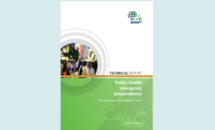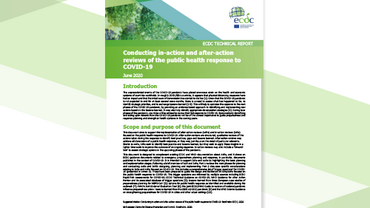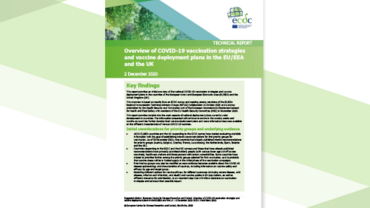Public health emergency preparedness: Core competencies for EU Member States
This report seeks to identify both the strengths and the areas for improvement of public health emergency preparedness (PHEP) in the European Union Member States. With the eventual goal of developing competency-based training programmes intended to improve PHEP, an initial step towards this goal consisted of the development of an ECDC public health emergency preparedness logic model that focuses particularly on cross-border threats to health in the European context. This logic model provides a structure for assessing preparedness in the Member States and, in its list of public health emergency preparedness capabilities, a language for describing and identifying gaps in the knowledge and skills of public health and preparedness professionals.
Executive summary
This technical report aims to take this work a step further by creating a linkage between the capabilities listed in the logic model for PHEP in the EU Member States – which apply at the emergency preparedness system level – with competencies for individuals who work in the system by generating a competency-based model. A subsequent phase, to be completed in 2017–2018, will involve the development and pilot testing of competency-based curricula.
Although informed by public health emergency practitioners, this report is primarily written for educators who will develop competency-based training programmes. It should also be useful for organisations that employ professionals trained in public health emergency preparedness. Public health emergency preparedness is very broad, diverse, and rather complex societal process of preparing and responding to health threats caused by communicable diseases and other cross-border threats to health.
ECDC has initiated a medium-term project aimed at designing competency-based training curricula for experts working in preparedness at the national level in the Member States. ‘Competency-based’ means that training participants acquire knowledge and skills based on a defined set of core competencies they need to best fulfil their job responsibilities. The competency-based approach enhances harmonisation and helps to ensure similar levels of competency throughout the EU, regardless of the background of those working in the field.
These competencies are intended to describe the knowledge and skills needed by experts working in preparedness at the national level such as national preparedness committee members or their equivalent. We recognise that the preparedness and emergency response structures of EU Member States vary, and use the term ‘national preparedness committee’ generically to describe the group of individuals who work on these issues in any given country. In general, however, public health preparedness is included in the emergency management structures in a country, which are usually led by interior affairs or civil protection staff. When an emergency is of a health nature, then health personnel typically take the lead.
While the PHEP logic model and competencies can be useful in preparedness planning, it is not ECDC’s goal to mandate any particular emergency response approach, structure, or capabilities. These are clearly the responsibility of the Member States and necessarily reflect each country’s own resources, administrative and political structures, as well as their responsibilities under Decision 1082 and the International Health Regulations (2005). Similarly, it is not ECDC’s intention to specify the knowledge or skills needed by any particular group of preparedness workers. Rather, our goal is to describe the competencies that different groups of professionals need – in addition to the basic knowledge and skills required for their profession – when they are called upon to serve as members of national preparedness committees or teams in order to facilitate an effective national and cross-border response to health threats in Europe.
Download







